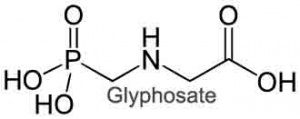Glyphosate

Glyphosate is used as an herbicide. It is applied to the leaves of plants to kill both broadleaf plants and grasses. The sodium salt form of glyphosate is used to regulate plant growth and ripen specific crops. Glyphosate was first registered for use in the U.S. in 1974. It is also an antibiotic and mineral chelator but may attack good microbe within the body digestive chemistry with severe repercussions.
A new study finds that bacteria develop antibiotic resistance up to 100,000 times faster when exposed to the world's most widely used herbicides, Roundup (glyphosate) and Kamba (dicamba) and antibiotics compared to without the herbicide.
Glyphosate may be an environmental hazard damaging the microbiology of the food chain from the soil to your gut bacteria contributing to an increase in a variety of deficiencies, illnesses, and genetic viability. Gastrointestinal, reproductive fertility of both plant and animals. Even autism and other brain disorders and genetic defects have increased in the reproduction of plants and animals.
While the EPA has determined that glyphosate is of “relatively low oral and dermal acute toxicity” but its effect on microbes in the soil and also in the digestive systems of animals may cause long-term harm and digestive and metabolizing problems. Glyphosate is not an acute toxin but it probably one of the most chronic toxins[1] being put into the environment.
Claims that it does not cause cancer were contradicted by recent judgments against Monsanto. The unanimous decision against Monsanto found them guilty on all charges and accused of malice, oppression or fraud, relating to their agrochemical, glyphosate. The jury awarded $289 million. The class action was led by a groundskeeper dying of cancer.
It may accumulate in the body with lasting detrimental effect/ The soil half-life of glyphosate is approximately 47 days (with a range of 2 to nearly 200 days depending on soil type and various environmental conditions). But it is not active for a vast majority of that time. In order for glyphosate to be active as a herbicide, it must first (obviously) enter the plant. Glyphosate does not degrade easily and courts have ruled you can not claim biodegradability.
In water, glyphosate is strongly adsorbed to suspended organic and mineral matter and is broken down primarily by microorganisms also. Its half-life in pond water ranges from 12 days to 10 weeks. Glyphosate may be extensively metabolized by some plants while remaining intact in others.
Professor Miguel A. Altieri of the University of California, Berkeley who had looked into unforeseen risks that might be associated with GMOs and Glyphosate:
- “Glyphosate is a systemic herbicide (i.e. it is absorbed into and moves through the whole plant), and is carried into the harvested parts of plants. Exactly how much glyphosate is present in the seeds of corn or soybeans (genetically engineered to withstand this chemical) is not known, as grain products are not included in conventional market surveys for pesticide residues. The fact that this and other herbicides are known to accumulate in fruits…raises questions about food safety, especially now that more than 37 million pounds of this herbicide are used annually in the United States alone. Even in the absence of immediate (acute) effects, it might take 40 years for a potential carcinogen to act in enough people for it to be detected as a cause. Moreover, research has shown that glyphosate seems to act in a similar fashion to antibiotics by altering soil biology rendering bean plants more vulnerable to disease”.
There are people looking for ways to lower exposure and detoxify glypphosate.
Agriculture |
Permaculture |
Garden |
Seeds |
Seeds of Life |
Seed shares |
Tilling of the Earth |
Allan Savory | Hugelkultur |
Milk |
GMO |
Food production |
Food Rising |
Food for thought |
Food Stamps |
Food Toxins |
Ingredients |
Health Share |
Fermentation |
Healthy Gut |
Rave Diet |
Politics of Health
- ↑ Chronic toxicity is the development of adverse effects as the result of long term exposure to a toxicant or other stressor. It can manifest as direct lethality but more commonly refers to sublethal endpoints such as decreased growth, reduced reproduction, or behavioral changes such as impacted swimming performance.